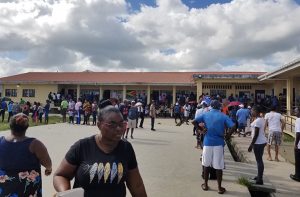NOTWITHSTANDING a 13.3 per cent increase in the number of eligible voters, overall voter turnout here in Guyana has remained relatively stable, as the 72.5 per cent recorded for the March 2, 2020 General and Regional Elections has proven.
The percentage at reference represents a marginal increase from the 71.3 per cent turnout recorded for the 2015 elections.
What this means in numerical terms is that 479,453 of the 660,998 persons deemed eligible to vote turned up at their respective polling stations on E-Day to cast their ballots. And of the said 479,453 ballots cast for general elections, a total of 5,917 were reportedly rejected for varying reasons, leaving 473, 556 valid votes cast in the 2020 elections.
This is based on results for the general elections, as thus far declared by Returning Officers of the country’s ten administrative regions. Some of the Regions, including the largest voting block, Region Four (Demerara-Mahaica), are currently undergoing a recount.
Considered a representation of the confidence of a populace in the political process, voters turning out to exercise their franchise is thought to be essential in a functioning democracy.
Notwithstanding the foregoing theory, voter turnout has been considered an issue in the wider Caribbean, where it has been reported that on average, more than one-third of the registered voters in the Region fail to turn up to vote on Election Day.
Over the years, voter turnout in Guyana has faced a steady decline, hitting its lowest in 2006 at 69.3 per cent, when compared to the 72.9 per cent recorded back in 2011.
SIGNIFICANT DECLINE
Nonetheless this still represents a significant decline from the 88.4 per cent and 91.7 per cent turnout recorded in the 1997 and 2001 elections respectively.
At the 2020 elections, voter turnout in the 10 Electoral Districts varied. In the districts, turnout percentages ranged from 76.7 per cent in Region Four, which had the highest number of eligible voters, to as low as 63.8 per cent in Region Eight (Potaro-Siparuni), which also had the lowest number of scheduled voters.
The percentages were calculated as a ratio of total votes cast, and not just valid votes.
In terms of turnover, seven out of the ten voting districts saw an increase in their voter turnout, with Regions Three (Essequibo Islands-West Demerara), Five (Mahaica-Berbice) and Six (East Berbice-Corentyne) being the regions that saw decreases, though marginal.
Notwithstanding these declines, all ten of the regions saw increases in the number of voters that exercised their democratic right, as was expected, given that all of the Regions saw significant increases in respective number of eligible voters.
In 2015, only 583, 445 voters were eligible to vote. That year the interim turnout ranged from 75.8 per cent in Region Five to 62.9 in Region Seven (Cuyuni-Mazaruni).
HIGHEST TURNOUT
In addition to having the highest turnout in 2020, the Region Four district also had the highest increase in voter turnout. Based on results declared by the Region Four Returning Officer, Clairmont Mingo, turnout in the region increased from 72.7 in 2015 to 76.7 per cent this year.
In terms of numbers, this means that 32,832 more voters for this Region went to cast their ballots in 2020 than they did in 2015. The Region had a total 285, 618 electors scheduled to vote this year, an increase of 29,478 from those on the Region’s Official List of Electors (OLE) in 2015.

In 2015, it was Region Five that had recorded the highest interim turnout, with 75.8 per cent of the then 40,177 voters casting their ballot. This year, the voter turnout in that Region dipped to 74.7 per cent, but still placed the Region among those with the highest turnout. Region Five had the second highest turnout behind Region Four. Following close behind were Regions Three at 72.4%; Two (Pomeroon-Supenaam) at 70.8%; and Nine (Upper Takutu-Upper Essequibo) at 70.1%.
Conversely, Region Six saw the biggest dip in voter turnout, dropping from 68.8 per cent in 2015 to 65.5 per cent this time around. In that Region, the number of voters who turned out only increased by approximately 2,200, notwithstanding the OLE increasing by just over 8000 voters.
Following close behind Regions Eight and Six, the lowest interim turnouts by Region in 2020 were recorded in Regions Seven at 65.5%; and One (Barima-Waini) at 65.8%.
As a result of the changes in amount of voters, naturally, there were increases in votes for both of the country’s two major political parties: The A Partnership for National Unity + Alliance for Change (APNU+AFC), and the People’s Progressive Party/Civic (PPP/C).
Both sides recorded their biggest increases in their traditional strongholds, however, there were significant changes in votes accumulated by the smaller parties, which translated to a decreased percentage of votes for both of the two major parties in several regions.
PERFORMANCE BY PARTY
APNU+AFC saw increases in number of votes in all but Region Six, where the party took 1,765 less votes than the 22,103 that it received in 2015. This translated to a decline by 4.1 per cent of the votes for this party in that Region.
As a matter of percentage, the party had its highest increase (2.3%) in Region Nine, however, this translated to just 1297 more votes. Meanwhile, though the party increased its percentage by just one per cent in Region Four, this translated to 22,602 more votes.
For the PPP/C there were increases in the number of votes in all ten of the voting districts. The party’s biggest increase by number of votes came in Region Three, where it received 7,375 more votes than in 2015.
The party’s greatest increase in percentage of voters was in Region 6, where it moved from accumulating 63.9 per cent of the votes in 2015 to 67.2 per cent of the votes in 2020.
Collectively, the small parties, of which there were nine at this year’s elections, saw small but noteworthy increases in number of votes as compared to 2015, particularly in Regions Two, Three, Four, Six, Seven and Eight.
These increases can be attributed to the introduction of several new parties at this year’s elections, particularly the Liberty and Justice Party (LJP), headed by Lennox Shuman, who is of Indigenous extract; Change Guyana (CG), headed by hotelier Robert Badal; and A New and United Guyana (ANUG), headed by former PPP/C Executive, Ralph Ramkarran.
Primarily targeting the Indigenous voters, Shuman’s party succeeded in making small but significant voter percentage changes in Regions Four, Seven, and Eight, while CG saw its biggest support in Regions Two, Three, Four, and Six.
Markedly, due to the LJP in Regions Seven and Eight, votes to small parties increased from 2.6 and 1.7 in 2015, to 10.9 and 10.8 respectively in 2020.
In Region Four, while small parties collectively received just 707 votes in 2015, in 2020, the group took 4,137 votes. Leading the list was ANUG, with 1,387 votes, while CG received 919 and LJP received 761.




.png)









